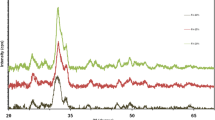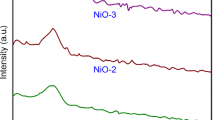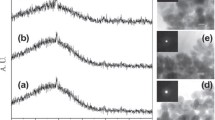Abstract
The purpose of this study was to evaluate physical–chemical and biocompatibility characteristics of a simple synthesis and low cost experimental bioactive glass. Physical and chemical properties were analyzed using scanning electron microscopy (SEM), X-ray energy dispersive (EDX), X-ray fluorescence (XRF) and X-ray diffraction (XRD). The biomaterials were subcutaneously implanted into rats, according to the following groups: G1, PerioGlas™; G2, Biogran™, G3, Experimental Bioactive Glass U (BGU) and G4, Control (Sham). After 7, 15, 21, 45, and 60 days, 5 animals/group/period were sacrificed and the subcutaneous tissue was dissected for histological and histometric analysis, considering inflammatory reaction and granulation area, presence of polymorphonuclear (PMN), monuclear (MN) and fibroblast (F) cells. SEM analysis of biomaterials showed irregular particles with different surface characteristics. EDX showed calcium, oxygen, sodium, phosphorus and silicon; XRF revealed silica oxide (SiO2), sodium oxide (Na2O), calcium oxide (CaO) and phosphorus oxide (P2O5). XRD indicated non crystalline phase. Measurement of tissue reaction showed similar results among the experimental groups at 45 and 60 days. No difference was found for PMN, MN and F cell counts. All biomaterials exhibited partial resorption. In conclusion, the experimental bioactive glass analyzed showed physical and chemical characteristics similar to the commercially available biomaterials, and was considered biocompatible, being partially reabsorbed in the subcutaneous tissue.








Similar content being viewed by others
References
D.C. Cancian, E. Hochuli-Vieira, R.A. Marcantonio, I.R. Garcia Junior, Utilization of autogenous bone, bioactive glasses, and calcium phosphate cement in surgical mandibular bone defects in Cebus apella monkeys. Int. J. Oral Maxillofac. Implants 19, 73 (2004)
A. El-Ghannam, H. Amin, T. Nasr, A. Shama, Enhancement of bone regeneration and graft material resorption using surface-modified bioactive glass in cortical and human maxillary cystic bone defects. Int. J. Oral Maxillofac. Implants 19, 184 (2004)
T. Turunen, J. Peltola, A. Yli-Urpo, R.P. Happonen, Bioactive glass granules as a bone adjunctive material in maxillary sinus floor augmentation. Clin. Oral Implants Res. 15, 135 (2004)
K.A. Al Ruhaimi, Bone graft substitutes: a comparative qualitative histologic review of current osteoconductive grafting materials. Int. J. Oral Maxillofac. Implants 16, 105 (2001)
C. Vitale-Brovarone, E. Verne, M. Bosetti, P. Appendino, M. Cannas, Microstructural and in vitro characterization of SiO2–Na2O–CaO–MgO glass-ceramic bioactive scaffolds for bone substitutes. J. Mater. Sci. Mater. Med. 16, 909 (2005)
E.A. Kaufmann, P. Ducheyne, I.M. Shapiro, Effect of varying physical properties of porous, surface modified bioactive glass 45S5 on osteoblast proliferation and maturation. J. Biomed. Mater. Res. 52, 783 (2000)
E.A. Kaufmann, P. Ducheyne, I.M. Shapiro, Effect of varying physical properties of porous, surface modified bioactive glass 45S5 on osteoblast proliferation and maturation. J. Biomed. Mater. Res. 52, 783 (2000)
S.B. Cho, F. Miyaji, T. Kokubo, T. Nakamura, Induction of bioactivity of a non-bioactive glass-ceramic by a chemical treatment. Biomaterials 18, 1479 (1997)
E. Schepers, L. Barbier, P. Ducheyne, Implant placement enhanced by bioactive glass particles of narrow size range. Int. J. Oral Maxillofac. Implants 13, 655 (1998)
D.L. Wheeler, K.E. Stokes Ke, R.G. Hoellrich, D.L. Chamberland, S.W. Mcloughlin, Effect of bioactive glass particle size on osseous regeneration of cancellous defects. J. Biomed. Mater. Res. 41, 527 (1998)
A.J. Salinas, J. Roman, M. Vallet-Regi, J.M. Oliveira, R.N. Correia, M.H. Fernandes, In vitro bioactivity of glass and glass-ceramics of the 3CaO × P2O5–CaO × SiO2–CaO × MgO × 2SiO2 system. Biomaterials 21, 251 (2000)
I.A. Silver, J. Deas, M.M. Erecinska, Interactions of bioactive glasses with osteoblasts in vitro: effects of 45S5 Bioglass, and 58S and 77S bioactive glasses on metabolism, intracellular ion concentrations and cell viability. Biomaterials 22, 175 (2001)
J. Roman, A. J. Salinas, M. Vallet-Regi, J.M. Oliveira, R.N. Correia, M.H. Fernandes, Role of acid attack in the in vitro bioactivity of a glass-ceramic of the 3CaO.P2O5–CaO.SiO2–CaO.MgO.2SiO2 system. Biomaterials 22, 2013 (2001)
A. Itälä, V.V. Välimäki, R. Kiviranta, H.O. Ylanen, M. Hupa, E. Vuorio, H.T. Aro, Molecular biologic comparison of new bone formation and resorption on microrough and smooth bioactive glass microspheres. J. Biomed. Mater. Res. B Appl. Biomater. 65, 170 (2003)
M. Cerruti, D. Greenspan, K. Powers, Effect of pH and ionic strength on the reactivity of Bioglass 45S5. Biomaterials 26, 1665 (2005)
W. Lai, J. Garino, C. Flaitz, P. Ducheyne, Excretion of resorption products from bioactive glass implanted in rabbit muscle. J. Biomed. Mater. Res. A 75, 398 (2005)
M. Vogel, C. Voigt, U.M. Gross, C.M. Muller-Mai, In vivo comparison of bioactive glass particles in rabbits. Biomaterials 22, 357 (2001)
M. Bosetti, L. Hench, M. Cannas, Interaction of bioactive glasses with peritoneal macrophages and monocytes in vitro. J. Biomed. Mater. Res. 60, 79 (2002)
T. Wilson, V. Parikka, J. Holmbom, H. Ylanen, R. Penttinen, Intact surface of bioactive glass S53P4 is resistant to osteoclastic activity. J. Biomed. Mater. Res. A 77, 67 (2006)
G.A. Silva, F.J. Costa, O.P. Coutinho, S. Radin, P. Ducheyne, R.L. Reis, Synthesis and evaluation of novel bioactive composite starch/bioactive glass microparticles. J. Biomed. Mater. Res. A 70, 442 (2004)
C. Knabe, M. Stiller, G.F. Berger, D. Reif, R. Gildenhaar, C.R. Howlett, H. Zreiqat, The effect of bioactive glass ceramics on the expression of bone-related genes and proteins in vitro. Clin. Oral Implants Res. 16, 119 (2005)
Acknowledgements
This work was supported by Coordenação de Aperfeiçoamento de Pessoal de Nível Superior (CAPES), Brazil.
Author information
Authors and Affiliations
Corresponding author
Rights and permissions
About this article
Cite this article
da Cruz, A.C.C., Pochapski, M.T., Tramonti, R. et al. Evaluation of physical–chemical properties and biocompatibility of a microrough and smooth bioactive glass particles. J Mater Sci: Mater Med 19, 2809–2817 (2008). https://doi.org/10.1007/s10856-008-3407-4
Received:
Accepted:
Published:
Issue Date:
DOI: https://doi.org/10.1007/s10856-008-3407-4




